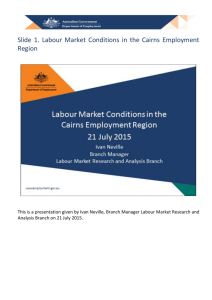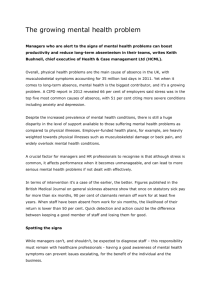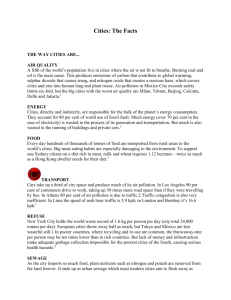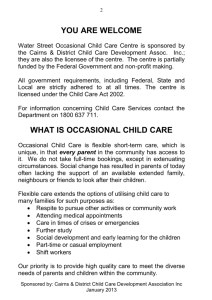DOCX file of Cairns Priority Employment Area Presentation
advertisement
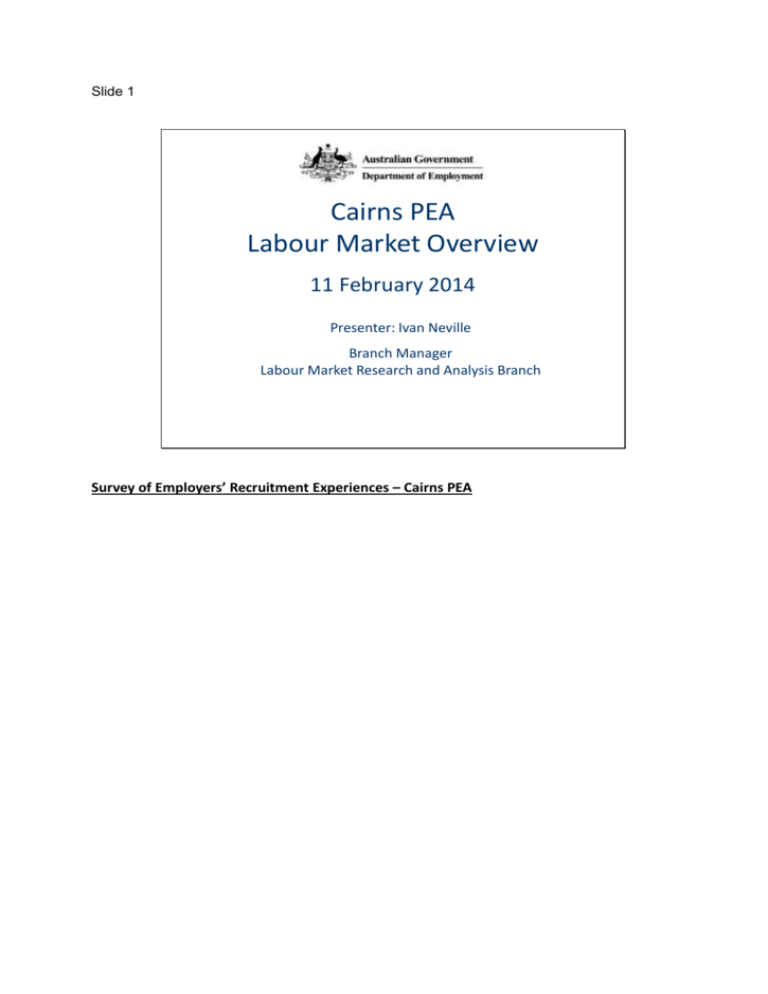
Slide 1
Cairns PEA
Labour Market Overview
11 February 2014
Presenter: Ivan Neville
Branch Manager
Labour Market Research and Analysis Branch
Survey of Employers’ Recruitment Experiences – Cairns PEA
Slide 2
Cairns Priority
Employment Area
The Cairns Priority Employment Area (PEA) makes up 91 per cent of the Far North labour force
region.
The Cairns Priority Region is made up of the following Local Government Areas:
Cairns LGA
Cassowary Coast LGA
Tablelands LGA
Yarrabah LGA
Please note that the boundaries in the map are based on the 2006 ASGC. Since this time there
has been a major consolidation of Local Government Areas in Queensland. This has affected all
LGAs in the Cairns Priority Employment Area.
•The Atherton, Eacham, Herberton and Mareeba LGAs now fall within the Tablelands LGA.
•The Cardwell and Johnston LGAs now falls within the Cassowary Coast LGA
•The Douglas LGA now falls within the Cairns LGA
•SLAs within the Cairns LGA:
- Cairns – Barron
- Cairns – Central Suburbs
- Cairns – City
- Cairns – Mt Whitfield
- Cairns – Northern Suburbs
- Cairns – Trinity
- Cairns – Western Suburbs
- Cairns – Pt B
- Douglas
•SLAs within the Cassowary Coast LGA:
- Cardwell
- Johnstone
•SLAs within the Tablelands LGA:
- Atherton
- Eacham
- Herberton
- Mareeba
•SLAs within the Yarrabah LGA:
- Yarrabah
Slide 3
Snapshot of the Region
Indicator
Cairns PEA
Queensland
Unemployment rate
7.7%
5.9%*
Working Age Participation rate (15- 64 years old)
76.8%
77.2%
Teenage full-time unemployment ratio
34.1%
28.3%
Average duration of unemployment (weeks)
42
35
Income support recipients (15-64 years old)
21%
17%
Indigenous unemployment (WAP)
28%
18%
Many families jobless
20%
14%
*Seasonally adjusted
Source: Department of Employment Small Area Labour Markets, September Quarter 2013;
ABS Labour Force Data, December 2013 (12 month averages, Far North Queensland LFR);
ABS, Census of Population and Housing, 2011; Department of Employment administrative
data, December 2013
Snapshot of the Region
Compared to the state of Queensland, the Cairns PEA labour market is largely subdued, with
consistently high unemployment, a large proportion of income support recipients and jobless
families, and long average duration of unemployment.
Slide 4
Cairns Population Profile
Adult Population
(15+) 2012
Growth (15+)
2007 to 2012
Median Age
2011
Cairns LGA
129,980
13%
36
Cassowary Coast LGA
23,270
2%
42
Tablelands LGA
36,360
7%
43
Yarrabah LGA
1,720
10%
22
Cairns PEA
191,330
10%
38
Queensland
3,658,500
12%
36
Australia
18,419,600
10%
37
Region
Source: ABS Estimated Residential Population 2012, ABS Census of Population and Housing 2011
Cairns Population Profile
Source: Estimated Residential Population, 2007 and 2012; ABS, Census of Population and
Housing, 2011 LGA and PEA population figures rounded to nearest 10, state and national to
nearest 100
The adult population in the Cairns PEA grew by 10 per cent from 2007 to 2012, on par with
Australia (10 per cent).
Slide 5
Age distribution
8%
7%
6%
5%
4%
3%
2%
Cairns PEA
Queensland
1%
0%
Source: ABS Estimated Residential Population, 2012
Age Distribution
Source: ABS Estimated Residential Population, 2012
This graph shows the age distributions of the Cairns PEA as of 2012.
While there is a dip in the 20-34 year old proportion of the population, this is relatively small
compared with some other regions in Australia.
Slide 6
Where are new arrivals coming from?
More than 40,000 people moved to Cairns
in the 5 years to 2011
1,800
Western
Australia
9,500
Overseas
Cairns PEA
4,600
NSW
3,400
Victoria
16,700
Rest of QLD
At least 26,500 people
moved from the PEA to
elsewhere in Australia
Source: ABS, Census of Population and Housing 2011 & 2006
Where are new arrivals coming from?
Source: ABS, Census of Population and Housing 2011 & 2006
Some 40,000 people moved to the Cairns PEA in the 5 years to 2011, with a large number of
these coming from elsewhere in Queensland (16,700) and overseas (9,500).
At least 26,500 people moved from the Cairns PEA to elsewhere in Australia. This does not
include those who had resided in the Cairns PEA in 2006 and who moved overseas by 2011.
Slide 7
International Visitors
Tropical North Queensland
16.0%
15.6%
13.9%
900
International Visitors to TNQ ('000)
14.0%
13.2%
809
12.0%
800
676
700
12.6%
11.9%
704
676
627
12.0%
633
10.0%
600
500
8.0%
400
6.0%
300
4.0%
200
2.0%
100
-
0.0%
2008
2009
2010
International Visitors to TNQ ('000)
2011
2012
TNQ share of International Visitors to Australia (%)
1,000
2013
TNQ share of International Visitors to Australia (%)
Source: Tourism Research Australia, September 2013
International Visitors- Tropical North Queensland
Source: Tourism Research Australia, September 2013
The number of international visitors to Tropical North Queensland declined substantially
following the global recession in 2008. However, visitor numbers had recovered somewhat
between 2012 and 2013.
__________________________________
Tropical North Queensland extends from Mission Beach/Tully in the south to the northern
(Cape York) and westernmost extremes of the state of Queensland. For example, Burketown
(Gulf of Carpentaria) is included, however Mt Isa is not.
Slide 8
Employment growth mostly among
part-time workers
Cairns PEA
WAP
25.0%
Full-time
19.5%
20.0%
Part-time
15.0%
13.6%
11.1%
10.0%
7.6%
5.0%
3.1%
0.4%
0.0%
Male
Female
Total
Source: ABS, Census of Population and Housing, 2011 and 2006
Employment growth mostly among part-time workers
Source: ABS, Census of Population and Housing, 2011 and 2006
Between 2006 and 2011, employment growth occurred mainly among part-time workers.
Growth in full-time male employment was very low (0.4 per cent) compared with part-time
growth (19.5 per cent). The difference between female full-time employment growth (7.6 per
cent) and part-time growth (11.1 per cent) was smaller.
Slide 9
Consistently higher unemployment rate…
12%
10%
8%
6%
4%
Cairns PEA
Australia
2%
Sep-13
Jun-13
Dec-12
Mar-13
Jun-12
Sep-12
Mar-12
Dec-11
Jun-11
Sep-11
Mar-11
Sep-10
Dec-10
Jun-10
Dec-09
Mar-10
Jun-09
Sep-09
Mar-09
Dec-08
Jun-08
Sep-08
Mar-08
0%
Source: Department of Employment Small Area Labour Markets, September
Quarter 2013; ABS Labour Force Data, November 2013 (12 month averages)
Consistently higher unemployment rate...
Source: Department of Employment Small Area Labour Markets, September Quarter 2013; ABS
Labour Force Data, November 2013 (12 month averages
The unemployment rate for the Cairns PEA has remained consistently above the national rate
since March 2008.
Slide 10
Regional disparity
Unemployment Rate
September 2013
Participation Rate
2011
Cairns LGA
7.7%
78.8%
Cassowary Coast LGA
6.6%
75.9%
Tablelands LGA
8.8%
70.9%
Yarrabah LGA
13.1%
54.1%
Cairns PEA
7.7%
76.8%
Queensland
5.8%*
77.2%
Region
*December 2013, Seasonally Adjusted
Source: Department of Employment, Small Area Labour Markets, September
Quarter 2013 (Smoothed); 6202.0 Labour Force, Queensland, December 2013
(Seasonally Adjusted); ABS, Census of Population and Housing, 2011
Regional disparity
Source: Department of Employment, Small Area Labour Markets, September Quarter 2013
(Smoothed), 6202.0 Labour Force, Queensland, December 2013 (Seasonally Adjusted), ABS,
Census of Population and Housing, 2011
In September 2013 the unemployment rate in the Cairns PEA was 7.7 per cent.
Within the Cairns PEA, the Yarrabah LGA had the highest unemployment rate
(13.1 per cent).
The Yarrabah LGA also had the lowest labour force participation rate (54.1 per cent). Labour
force participation in the Cairns LGA was relatively high (78.8 per cent).
Slide 11
Long duration of unemployment
Long-term unemployed
(52 weeks or more)
Region
Average duration
of unemployment
(weeks)
Persons
Percent of all
unemployed
Far North Qld LFR
2,470
28%
42
Queensland
23,100
20%
35
Australia
109,000
21%
37
Source: ABS Labour Force, December 2013 (12 month averages)
Long duration of unemployment
Source: ABS Labour Force, December 2013 (12 month averages)
Long-term unemployed are those who have been unemployed and looking for work for at least
52 weeks.
A larger proportion of people in the Far North Queensland LFR were considered long term
unemployed (28 per cent) compared with Queensland (20 per cent) and Australia (21 per cent).
The average duration of unemployment in the Far North Queensland LFR was 42 weeks,
significantly higher compared with the state (35 weeks) and national averages (37 weeks).
Slide 12
Many families jobless
Jobless families with children under 15
Jobless
families
% of all
families
Cairns LGA
2980
19%
Cassowary Coast LGA
485
19%
Tablelands LGA
804
20%
Yarrabah LGA
244
72%
Cairns PEA
4,513
20%
Queensland
62,169
14%
Region
Source: ABS, Census of Population and Housing, 2011
Many families jobless
Source: ABS, Census of Population and Housing, 2011
The proportion of jobless families (20 per cent) is substantially higher compared with the state
of Queensland (14 per cent).
Slide 13
High rates of income support
Region
Proportion of the
Change for all
Proportion of the
Change for all
WAP in receipt of unemployment
WAP in receipt of benefit recipients
an unemployment benefit recipients
benefit
(Dec 12 to Dec 13)
benefit
(Dec 12 to Dec 13)
Cairns LGA
21%
0.1%
8%
10.3%
Cassowary Coast LGA
21%
-6.3%
8%
-1.4%
Tablelands LGA
25%
-0.8%
10%
12.2%
Cairns PEA
21%
-1.6%
9%
8.0%
Queensland
17%
2.4%
6%
15.8%
Source: Department of Employment administrative data, December
2013 and December 2012; Estimated Residential Population, 2012
High rates of income support
Source: Department of Employment, Administrative data, December 2013 and December 2012;
Estimated Resident Population, 2012
In December 2013, 21 per cent of the Working Age Population (WAP) were in receipt of an
income support payment in the Cairns PEA. This was larger when compared with Queensland
(17 per cent). In the Tablelands LGA, 25 per cent of the WAP was in receipt of an income
support payment.
Some 9 per cent of the Cairns PEA (WAP) were in receipt of an unemployment benefit, higher
than the state (6 per cent).
10 per cent of the WAP in the Tablelands LGA were in receipt of an unemployment benefit.
Slide 14
Teenagers experiencing labour market challenges
Teenage full-time unemployment
(15-19 years)
Teenage full-time
unemployment to
population ratio
Region
Persons
Teenage full-time
unemployment rate
Far North Qld LFR
1,600
34.1%
7.5%
Queensland
17,500
28.3%
5.5%
Australia
60,800
25.8%
4.1%
Source: ABS Labour Force data, December 2013 (12 month average)
Teenagers experiencing labour market challenges
Source: ABS Labour Force data, December 2013 (12 month average)
Due to their lack of skills and experience, teenagers in the full-time labour market can be
particularly vulnerable during a labour market downturn.
The teenage full-time unemployment rate is the proportion of those aged 15 to 19 years,
participating full-time in the labour market, who are unemployed.
As at December 2013, the teenage full-time unemployment rate for the Far North Queensland
LFR was 34.1 per cent, higher than both the state (28.3 per cent) and national (25.8 per cent)
rate.
As at November 2013, the teenage full-time unemployment to teenage population ratio in the
Far North Queensland LFR (7.5 per cent) was higher than both the state (5.5 per cent) and
national (4.1 per cent) averages.
*The Cairns PEA comprises 91 per cent of the working age population (15-64 years) of the Far
North LFR.
Slide 15
What are the youth doing?
Population (15-24 years):
24,140
Not Studying:
13,650 (57%)
Studying:
10,490 (43%)
Employed:
9,480 (40%)
Completed
Year 12:
6,450 (27%)
Did Not Complete
Year 12:
3,030 (13%)
Not Employed:
4,170 (17%)
Completed
Year 12:
1790 (7%)
Did Not Complete
Year 12:
2380 (10%)
Source: ABS, Census of Population and Housing, 2011
What are the youth doing?
Source: ABS, Census of Population and Housing, 2011
At the time of the 2011 Census, there were 24,140 15-24 year olds in the Cairns PEA, of whom
13,650 (57 per cent) were not studying.
In particular, 17 per cent (4,170 people) of youth aged 20 to 24 were not studying and not
employed and 10 per cent (2,380 people) had not completed Year 12. These figures are higher
compared with Queensland, where 12 per cent of youth aged 20 to 24 were not studying and
not employed and 7 per cent had also not completed Year 12. This group is especially at risk
given their lack of Year 12 Certificate and level of disengagement within the labour market.
Note: Not stated records for FT/PT Student Status, Labour Force Status and Higher Year of
School Completed have not been included.
Slide 16
Young people disengaged in Cairns PEA
20 – 24 Years
40%
Not In the Labour Force
35%
Unemployed
30%
25%
31%
20%
15%
12%
20%
9%
10%
5%
10%
6%
6%
11%
6%
6%
4%
Female
Male
Female
10%
0%
Male
Female
Tablelands LGA
Male
Cairns PEA
Australia
Source: ABS Census of Population and Housing, 2011
Young people disengaged in Cairns PEA
Source: ABS, Census of Population and Housing, 2011
For young adult males in the PEA, 9 per cent were not in the labour force and not studying and
10 per cent were unemployed and not studying. For young adult females in the PEA, 20 per cent
were not in the labour force and not studying and a further 6 per cent were unemployed and
not studying.
The proportion of those aged 20-24 years in the Tablelands LGA who were neither working nor
studying was particularly high. Some 10 per cent of males were unemployed and not studying,
while 12 per cent were not in the labour force and not studying. While 6 per cent of females
aged 20-24 were unemployed and not studying, a very large proportion (31 per cent) were not
in the labour force and not studying.
Slide 17
Low levels of educational Attainment
Persons aged 25-34 years
Completed Yr 12
Region
Attained
Advanced
Diploma,
Diploma or
Certificate
III & IV
Attained
Bachelor
Degree or
Higher
2011
2006
Cairns LGA
71%
69%
36%
22%
Cassowary Coast LGA
63%
56%
34%
14%
Tablelands LGA
63%
60%
34%
15%
Yarrabah LGA
37%
31%
14%
2%
Cairns PEA
69%
66%
35%
20%
Queensland
74%
68%
32%
29%
Source: ABS, Census of Population and Housing, 2011
Educational attainment:
Source: ABS, Census of Population and Housing, 2011
Job seekers who have not completed Year 12 and have limited experience in the workforce are
likely to lack many basic employability skills that employers value and look for in applicants,
particularly for lower skilled vacancies and entry level positions such as apprenticeships and
traineeships.
At the time of the 2011 Census, the proportion of 25 to 34 year olds in the Cairns PEA who had
completed Year 12 or equivalent was 69 per cent, smaller than Queensland (74 per cent).
20 per cent of 25-34 year olds in the Cairns PEA had attained a Bachelor Degree or Higher, lower
than Queensland (29 per cent). However, the proportion of people in the PEA who attained an
Advanced Diploma, Diploma, or Certificate III and IV level (35 per cent) was larger than
Queensland (32 per cent).
Slide 18
Educational Attainment and Labour Market Outcomes
Persons aged 25-34 years
44.0%
100.0%
90.0%
89.7%
87.3%
90.0%
36.0%
77.9%
Unemployment Rate (%)
32.0%
28.0%
80.0%
74.4%
27.2%
64.9%
Unemployment Rate
60.0%
24.0%
20.0%
19.7%
Participation Rate
16.0%
50.0%
40.0%
12.0%
8.1%
8.0%
4.0%
70.0%
4.8%
4.9%
Advanced
Diploma /
Diploma
Certificate III /
IV
30.0%
Participation Rate (%)
40.0%
20.0%
2.5%
0.0%
10.0%
Bachelor
Degree or
higher
Year 12 or Certificate I / II Below Year 12
equivalent
Source: ABS Census of Population and Housing, 2011
Educational Attainment and Labour Market Outcomes
Source: ABS Census of Population and Housing, 2011
There is a strong relationship between educational attainment and employment outcomes. For
those aged 25 to 34 years in the Cairns PEA, there were high unemployment rates for those who
had completed Certificate I & II but had not completed Year 12 (27.2 per cent) and those who
did not complete Year 12 without any further post school qualification (19.7 per cent).
Unemployment rates are considerably lower for those who have completed a tertiary education
at the Bachelor degree, Advanced Diploma and Diploma Level. It should also be noted that
employment outcomes are better for those who have attained Certificate Levels III or IV. This
emphasises the importance of post school education in ensuring success in gaining
employment.
Slide 19
Indigenous labour market outcomes
Unemployment Rate
Participation Rate
Indigenous
Population
(WAP)
Indigenous
NonIndigenous
Cairns LGA
8%
24%
6%
57%
81%
Cassowary Coast LGA
9%
19%
5%
59%
78%
Tablelands LGA
11%
29%
6%
41%
74%
Yarrabah LGA
97%
63%
26%
54%
78%
Cairns PEA
10%
28%
6%
54%
79%
Queensland
3%
18%
6%
60%
78%
Region
Indigenous Non-Indigenous
Source: ABS, Census of Population and Housing, 2011
Indigenous labour market outcomes
Source: ABS, Census of Population and Housing, 2011
A relatively high proportion of the working age population of the Cairns PEA
(10 per cent) is from an Indigenous background compared with Queensland
(3 per cent)
Indigenous people in the Cairns PEA typically face weaker labour market outcomes, with high
unemployment (28 per cent) and low participation (54 per cent) compared with NonIndigenous people.
Slide 20
Largest employing industries
Working age population (15 – 64)
12%
12%
Health Care and Social Assistance
Retail Trade
11%
Accommodation and Food Services
12%
10%
7%
9%
9%
Construction
8%
8%
Education and Training
Public Administration and Safety
8%
7%
Transport, Postal and Warehousing
Cairns PEA
Australia
6%
5%
6%
Manufacturing
Agriculture, Forestry and Fishing
5%
2%
0%
2%
9%
4%
6%
8%
10%
12%
14%
Source: ABS Census of Population and Housing 2011
Largest employing industries
Source: ABS Census of Population and Housing 2011
The largest employing industries in the Cairns PEA are the Health Care and Social Assistance (12
per cent), Retail Trade (12 per cent), Accommodation and Food Services (10 per cent) and
Construction (9 per cent).
Slide 21
5 year change in employment
Largest employing industries, working age population (15 – 64)
Health Care and Social Assistance
36%
Education and Training
18%
Public Administration and Safety
3%
Construction
2%
Transport, Postal and Warehousing
0%
Retail Trade
0%
Accommodation and Food Services
Agriculture, Forestry and Fishing
Manufacturing
-1%
-6%
-8%
-15% -10%
-5%
0%
5%
10%
15%
20%
25%
30%
35%
40%
Source: ABS Census of Population and Housing 2006 and 2011
5 year change in employment
Source: ABS Census of Population and Housing 2006 and 2011
Employment in the Health Care and Social Assistance industry increased by
36 per cent in the 5 years to 2011.
By contrast, employment growth was low or negative in Manufacturing (-8 per cent),
Agriculture Forestry and Fishing (-6 per cent), Accommodation and Food Services
(-1 per cent) and Retail Trade (0 per cent).
Total employment growth across all industries in the Cairns PEA was 7 per cent compared with
10 per cent for Australia.
Slide 22
Projected employment growth
Largest employing industries, Far North Queensland LFR
Health Care and Social Assistance
3.0
Construction
2.3
Education and Training
1.6
Transport, Postal and Warehousing
1.0
Accommodation and Food Services
0.2
Agriculture, Forestry and Fishing
0.1
Retail Trade
-0.4
Manufacturing
-0.5
-1.0
-0.5
0.0
0.5
1.0
1.5
(‘000)
2.0
2.5
3.0
3.5
Source: Department of Employment, Employment Projections
(5 years from November 2012 to November 2017)
Projected employment growth, largest employing industries
Source: Department of Employment, Employment Projections
(5 years from November 2012 to November 2017)
This graph shows the projected employment growth by industry in the Cairns PEA. Much of the
growth in employment within the PEA is expected to be in Health Care and Social Assistance
and Construction industries.
The Retail Trade and Manufacturing industry is expected to decrease.
Slide 23
Recruitment activity varied
• 67 per cent of employers in the Cairns PEA recruited in the
past 12 months
- Recruitment activity was particularly high in the
Accommodation and Food Services (80 per cent) and
Health Care and Social Assistance (77 per cent) industries
• Only 1.8 per cent of vacancies remained unfilled
- Unfilled vacancies were higher for Managers and
Professionals (5.9 per cent) and Technicians and Trades
Workers (5.6 per cent)
• Recruitment difficulty was low (31 per cent)
• Staff turnover was the main driver of recruitment activity
Source: Department of Employment, Survey of Employers’ Recruitment
Experiences, July 2013, Cairns Priority Employment Area
Recruitment activity varied
Source: Department of Employment, Survey of Employers’ Recruitment Experiences, July 2013,
Cairns Priority Employment Area
387 employers were surveyed in the Cairns PEA in July 2013.
Unfilled vacancies in employers’ most recent recruitment round were low
(1.8 per cent).
Slide 24
Strong competition but few suitable applicants
Managers and Professionals
1.5
Technicians and Trades Workers
1.4
Community and Personal Service Workers
1.6
Clerical and Administrative Workers
12.2
10.4
7.4
28.0
2.2
Sales Workers
1.4
Machinery Operators and Drivers
1.3
Labourers
1.1
Cairns PEA 2013
1.4
Cairns PEA 2012
7.4
10.1
10.0
10.9
3.7
All regions surveyed, 12 months to March 2013
2.4
0.0
Average number of
applicants per
vacancy
5.7
5.0
Average number of
applicants suitable
8.8
10.0
15.0
20.0
25.0
30.0
Source: Department of Employment, Survey of Employers’ Recruitment Experiences,
July 2013, Cairns Priority Employment Area
Strong competition but few suitable applicants
Source: Department of Employment, Survey of Employers’ Recruitment Experiences, July 2013,
Cairns Priority Employment Area
Competition for vacancies was high in the Cairns PEA, with an average of 10.0 applicants per
vacancy.
Clerical and Administration workers had the strongest competition for vacancies (28.0
applicants per vacancy), followed by Managers and Professionals
(12.2 applicants per vacancy).
Slide 25
The recruitment process
In the Cairns PEA
Average number of
applicants per vacancy
Not Interviewed
Average number of
applicants interviewed
Average number of
interviewed applicants
who were suitable
Why People don’t get an Interview?
- Lack of relevant experience
- Insufficient qualifications or training
- Poor application
- Basic employability skills
Source: Department of Employment, Survey of Employers’ Recruitment Experiences,
July 2013, Cairns Priority Employment Area
The recruitment process – Cairns PEA
Source: Department of Employment, Survey of Employers’ Recruitment Experiences, July 2013,
Cairns Priority Employment Area
This slide shows the recruitment process employers go through in the Cairns PEA.
On average employers in Cairns receive 10 (10.0) applicants per vacancy
Of these applicants on average only 3 (2.6) are interviewed.
Of these interviewed applicants only 1 (1.4) are suitable for the vacancy.
The reason those applicants do not get an interview were:
Lack of relevant experience
Insufficient qualifications or training
Poor application
Basic employability skills
Slide 26
Basic employability skills
• Employers frequently identified the following employability
skills:
–
–
–
–
–
–
Self-motivation
Good presentation
Friendliness
Communication skills
Confidence
Teamwork
Source: DEEWR, Survey of Employers’ Recruitment Experiences, All regions
surveyed in the 12 months to December 2010
Basic Employability Skills
Source: DEEWR, Survey of Employers’ Recruitment Experiences, All regions surveyed in the 12
months to December 2010
Employers frequently identified the following employability skills:
– Self-motivation
– Good presentation
– Friendliness
– Communication skills
– Confidence
– Teamwork
Slide 27
Many employers use informal methods
Formal method
15 applicants, 3 interviewed
60%
Informal method ONLY
3 applicants, 2 interviewed
40%
Source: Department of Employment, Survey of Employers’ Recruitment Experiences
Cairns Priority Employment Area, July 2013
Many employers use informal methods
Source: Department of Employment, Survey of Employers’ Recruitment Experiences Cairns
Priority Employment Area, July 2013
A large proportion (40 per cent) of employers used informal methods only. On average,
competition for vacancies was lower when employers used informal methods only, with an
average of 3 applicants per vacancy, or whom 2 received an interview.
Slide 28
Occupations difficult to fill
Higher Skill Level – Bachelor Degree or higher
Medium Skill Level - Certificate IV to Associate Degree
*Chefs
Early Childhood (Pre-primary School)
Teachers
*Motor Mechanics
*Air conditioning and Refrigeration
Mechanics
Lower Skill Level – Compulsory Secondary Education to Certificate III
Bar Attendants and Baristas
Motor Vehicle and Vehicle Parts
Salespersons
*Retail Supervisors
* Occupations also stated as difficult to fill in 2012
Source: Department of Employment, Survey of Employers’ Recruitment
Experiences, July 2013, Cairns Priority Employment Area
Occupations Difficult to Fill
Source: Department of Employment, Survey of Employers’ Recruitment Experiences, July 2013,
Cairns Priority Employment Area
This slide shows the vacancies that employers considered difficult to fill in the Cairns PEA.
Higher Skill Level – Bachelor Degree or higher Medium Skill Level - Certificate IV to Associate
Degree
Chefs
Early Childhood (Pre-primary School) Teachers
Motor Mechanics
Air conditioning and Refrigeration Mechanics
Lower Skill Level – Compulsory Secondary Education to Certificate III
Bar Attendants and Baristas
Motor Vehicle and Vehicle Parts Salespersons
Retail Supervisors
Slide 29
Recruitment outlook….
• 38 per cent of employers expected to recruit in the
next 12 months
• 17 per cent of employers expected to increase staff
numbers in the next 12 months
• Strong recruitment expected in the
Accommodation and Food Services and Health Care
and Social Assistance industries
• Employers expect to recruit for occupations such as
Sales Assistants (General), Bar Attendants and
Baristas , Waiters, Housekeepers, Chefs and
Kitchenhands
Source: Department of Employment, Survey of Employers’ Recruitment
Experiences, July 2013, Cairns Priority Employment Area
Recruitment outlook….
Source: Department of Employment, Survey of Employers’ Recruitment Experiences, July 2013,
Cairns Priority Employment Area
38 per cent of employers expected to recruit in the next 12 months
17 per cent of employers expected to increase staff numbers in the next 12 months
Strong recruitment expected in the Accommodation and Food Services and Health Care and
Social Assistance industries in the next 12 months
Employers expect to recruit for occupations such as Sales Assistants (General), Bar Attendants
and Baristas , Waiters, Housekeepers, Chefs and Kitchenhands
Slide 30
Single greatest concern for the future
In the Cairns PEA
Demand/ economy
8%
7%
55%
Recruitment or retention
difficulty/ skill shortages
Wages and Costs
16%
No concerns
14%
Other
Source: Department of Employment, Survey of Employers’ Recruitment
Experiences, July 2013, Cairns Priority Employment Area
Single greatest concern for the future (in the 12 months following the survey)
Source: Department of Employment, Survey of Employers’ Recruitment Experiences, July 2013,
Cairns Priority Employment Area
By far the single greatest future concern for employers was a downturn in the economy and
demand for their services/products (55% of employers). Recruitment or retention difficulty/skill
shortages was a concern for 8% of employers.
Slide 31
Conclusion
Labour market subdued
• Unemployment rate still high despite recent improvements
• Strong competition for limited vacancies
Challenges
• Teenage unemployment, disengaged youth, low education levels, high levels of income
support, jobless families, long-term unemployed and Indigenous unemployment
• Creating pathways into new opportunities
• Future labour supply
Opportunities
• Strong employment growth expected in the Health Care and Social Assistance
• Employment opportunities from strengthening Tourism sector
• Many major development projects in the pipeline likely to impact on demand for labour
Job seekers need to have…
• Employability skills, positive attitudes
• Education and Training
Collaboration with key stakeholders
Conclusion
Labour market subdued
•
Unemployment rate still high despite recent improvements
•
Strong competition for limited vacancies
Challenges
•
Teenage unemployment, disengaged youth, low education levels, high levels of income
support, jobless families, long-term unemployed and Indigenous unemployment
•
Creating pathways into new opportunities
•
Future labour supply
Opportunities
•
Strong employment growth expected in the Health Care and Social Assistance
•
Employment opportunities from strengthening Tourism sector
•
Many major development projects in the pipeline likely to impact on demand for labour
Job seekers need to have…
•
Employability skills, positive attitudes
•
Education and Training
Collaboration with key stakeholders
Slide 32
Further Information
– www.employment.gov.au/regionalreports
– www.lmip.gov.au
– www.emplyoment.gov.au/SkillShortages
– www.employment.gov.au/australianjobs
– www.joboutlook.gov.au
Further Information
More information on labour market conditions and other research on small areas can be found
on these web sites:
•
•
•
•
•
•
www.deewr.gov.au/RegionalReports
www.deewr.gov.au/LMIP
www.deewr.gov.au/SkillShortages
www.deewr.gov.au/australianjobs
www.joboutlook.gov.au
www.deewr.gov.au/news/aussie-jobs-publication-highlights-employment-growth
A report on the survey findings for the Bundaberg-Hervey Bay Priority Employment Area will be
placed on the regional reports section of the Department of Employment web site.
Thank you.
Slide 33
If you have any questions about the
presentation please contact the Employer
Surveys Section or Recruitment Analysis
Section on:
Tel: 1800 059 439 or
Email: recruitmentsurveys@deewr.gov.au
If you have any questions about the presentation please contact the Employers Surveys Section
or Recruitment Analysis Section on:
Tel: 1800 059 439 or
Email: recruitmentsurveys@deewr.gov.au
Slide 34
Australian Government
Department of Employment
